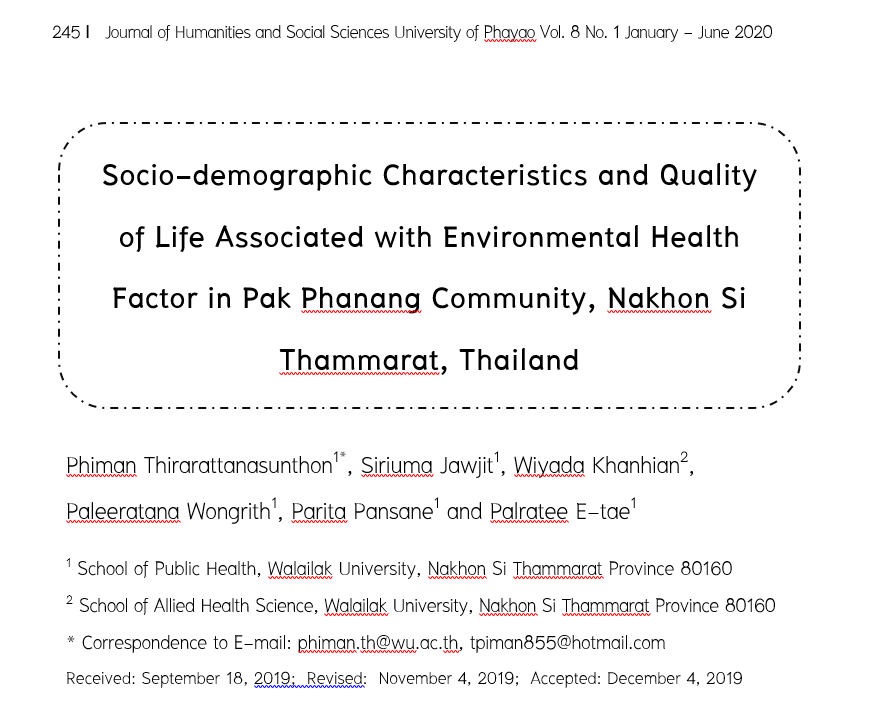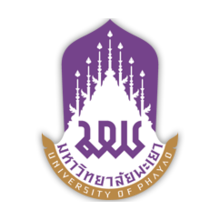Socio-demographic Characteristics and Quality of Life Associated with Environmental Health Factor in Pak Panang Community, Nakhon Si Thammarat, Thailand
Keywords:
Environmental Health, Socio-demographic, Quality of lifeAbstract
Purpose This study is a descriptive study with the aim to determine Socio-demographic Characteristics and quality of life associated environmental health impact factors in Klongnoi Community Pak Panang district Nakhon Si Thammarat province
Design/Methodology Overall, 433 Participants were interviewed altogether with questionnaires. An environmental Health Assessment Prevalence of Parasitic disease was conducted, by fecal examination and focus group advancement by representatives from the Village Health Volunteers "VHV".
Findings 80%of them were female aged more than 30 years old; with an average age of being 54.17 years old. 95%of them were Buddhist, and 5% were Muslim. Their marital status showed that 79% of them were married. The majority, which was 63%, showed that they had graduated from primary school; with an income between 8,500 Thai Bath a month. Furthermore, 73% of them were shown to be inadequate; with an average of 3 family members, an average 2 of family member that needed to be tended to. In the last 3 months, 38% of them had an illness, and 44% of them had a chronic disease. The most common diseases that these individuals had were; Diabetes Mellitus (DM) and Hypertension (HT). They did not receive annual medical checkups, and 57% obtained government services for their illnesses for their right to medical attention. For health behavioral factors, some of them had been smoking, and drinking alcohol. In addition, 23% of them ignored to exercise, and 17% of them still ate raw and semi-raw food. Their food behavior, lead to a high consumption in sweets; and in turn high caloric intake overall. For Socio-economic status, it was found that most of them had debt and most of barriers were consuming by 43%. The environmental health obstacles in the area were waste, rodents, insects, water supply and chemical pesticide being used. Also, there have been major issues with the broken road in the community, accident, and safety social issues. Most of them had an excellent quality of life, at 54%. From the sample group, 291 of them had a stool examination with a direct wet smear for parasite prevalence of disease. The data showed 1.72% of prevalence with Ascaris lumbricoid egg, strongyloides stercoralis rhabitiform lava; of which the same person was found in the equilibrium of parasites at a percentage of 2.41.
Conclusion In terms of the focus group discussion, it was found that participation of the community on environmental problems especially waste management water supply and flooding were the main issues; of which the community needed to solve. Lastly, Socio-economic status is associated with both health and quality of life; therefore integration with an organization to solve problems was in desperate need.
References
Ampon Jindawatthana, Archananupap, S., & Pipatrodnokamol, S. (2008). Health Promotion : Concepts, Principles, and Lessons from Thailand, Mho Choa Bann. (2nd edition ed.) : Bangkok: [m.p.].
Arporn Phaowattana, Surinthorn Klupakorn, Sunee lakumpan, & Amnartsatsea, K. (2012). Health promotion and disease prevention in the community : application of concepts and theories.
Bualuang, C. (2005). Development of preventive behaviors of pesticide users of chemical spraying farmers Group 3 Ban Prasat, Tambon Paiyai, Ban Mai District. (Master of Arts Master Thesis), Lop Buri : Thepsatri Rajabhat University.
Chamaroek, U. (2007). The use of chili peppers: a case study of farmers in Khomarat District, Ubon Ratchathani Province. (Master of Arts Master's thesis), Ubon Ratchathani : Ubon Ratchathani Rajabhat University.
Chinno, A. (2010). Behavior in the use and protection of agricultural chemicals, Kalasin Province. Journal of Health Research and Development, 3(3), 49-57.
Department, P. C. (2006). Report on Thai State of pollution Retrieved from Health Center, N. S. T. (2013). Summary and statistics of illness. Retrieved from http://www.nakhonsihealth.org/info/index.php?file=data_h_status.html
Jaikaroon, S., & Nathapinthu. K. (2002). Pesticide Use in the Behavior of Farmers Case Study: Ban Bueng Nuea, Bueng Niam Sub-district, Muang District, Khon Kaen Graduate School, KKU Research Journal (Graduate Studies), 6(3), 139-148.
Jha, M. K., Sondhi, O.A.K., & Pansare, M. (2003). Solid waste management – a case study. Indian Journal of Environmental Protection, 23, 1153-11260.
Keangkai Jumrenma, Sarut Sutthiarom, Sirjumnon Sirjunthana, Sanyanee Sirkacha, Butsabong Manutmankong, Wiphada PlodKornburi, & Wongnikong, W. (2009). Behavior and effects of insecticides and citrus mites on farmers in Fang and Mae Ai districts. Chiang Mai : Chiang Mai University, Department of Agriculture.
Komatra Chuengsatiansup, Kanisorn Tengrang, Ratree Pinkaew, & Petchkong, W. (2002). Community Way: Learning Guide that makes the community easy, effective and fun Global scale is stable estate. Nonthaburi: Health Systems Research Institute.
World Health Organisation. Environmental health impact assessment: Principles and practice. Retrieved from http://www.wpro.who.int/NR/rdonlyres/19 CA5607-2 D28-4 E41-B8F9. 281FCE8003DA/0/EHIAPrinciplesandpracticeMrRobertBos.pdf)
Singhal, S., & Pande, S. (2001). Solid waste management: status and future direction. TERI Information Monitor on Environmental Science, 6, 1-4.
Sujittra Yodjun, Janraja Suntayakorn, Narongsak Sornnu, & Prajanban, P. (2011). Effect of health belief program on self-protection behavior of pesticide use among farmers. Journal of Nursing and Health, 5(2), 45-54.

Downloads
Published
How to Cite
Issue
Section
License
ผู้นิพนธ์ต้องรับผิดชอบข้อความในบทนิพนธ์ของตน มหาวิทยาลัยพะเยาไม่จำเป็นต้องเห็นด้วยกับบทความที่ตีพิมพ์เสมอไป ผู้สนใจสามารถคัดลอก และนำไปใช้ได้ แต่จะต้องขออนุมัติเจ้าของ และได้รับการอนุมัติเป็นลายลักษณ์อักษรก่อน พร้อมกับมีการอ้างอิงและกล่าวคำขอบคุณให้ถูกต้องด้วย
The authors are themselves responsible for their contents. Signed articles may not always reflect the opinion of University of Phayao. The articles can be reproduced and reprinted, provided that permission is given by the authors and acknowledgement must be given.







